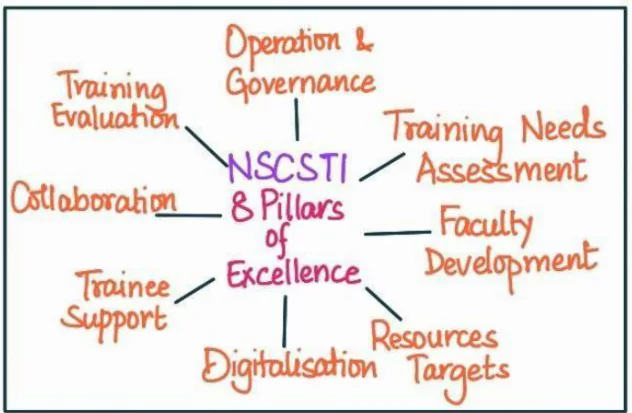Answer:
|
How to approach the question
- Introduction
- Write about NSCSTI briefly
- Body
- Write the challenges faced in strengthening ethical and moral values in Indian governance.
- Write the significance of recently launched NSCSTI in promoting ethical governance.
- Conclusion
- Give appropriate conclusion in this regard.
|
Introduction
Recently, the National standards for civil service training institutions (NSCSTI) was developed by Capacity Building Commission (CBC). India became the first country in the world to come out with a unique model to create standards for civil service training institutions at national level.
Body
Challenges faced in strengthening ethical and moral values in Indian governance
- Lack of accountability: Inadequate mechanisms to hold public officials accountable enables unethical practices. For instance, the 2010 Commonwealth Games corruption scandal.
- Nepotism: Favoritism and nepotism undermine meritocracy and ethical decision-making. The appointment of relatives to influential positions, such as the case of political leaders appointing family members to key government posts.
- Red tape and bureaucracy: Cumbersome bureaucratic processes contribute to unethical behavior, such as bribery and extortion, to expedite work. The long-drawn process of obtaining licenses and permits often leads to corrupt practices.
- Cultural factors: Deep-rooted cultural norms and apathy towards corruption and unethical practices can be challenging to address. Societal acceptance of corruption, as illustrated by the prevalence of “bribe culture” showcases this.
- Lack of ethical training: Insufficient emphasis on ethics in the education and training of civil servants hampers the development of a strong ethical foundation. This can lead to ethical dilemmas and compromised decision-making in critical situations.
Significance of recently launched NSCSTI in promoting ethical governance
- Operations and Governance: It ensures that civil services training institutions follow transparent and accountable practices, fostering ethical conduct, like implementing stringent protocols for the selection of trainers and training modules.
- Training Evaluation: It emphasizes the assessment of training programs to ensure that they promote ethical values. Evaluation criteria can include assessing participants’ understanding of ethical principles and their ability to apply them.
 Collaboration: It encourages collaboration among training institutions, fostering a culture of shared values and ethics. This collaboration can involve organizing joint workshops on ethical decision- making, where different institutions contribute.
Collaboration: It encourages collaboration among training institutions, fostering a culture of shared values and ethics. This collaboration can involve organizing joint workshops on ethical decision- making, where different institutions contribute.- Trainee Support: It emphasizes providing comprehensive support to trainees. For instance, organizing mentoring programs where experienced civil servants guide new recruits on ethical dilemmas they may face in their roles.
- Digitalisation: NSCSTI promotes the use of technology in training, ensuring that ethical considerations are incorporated into digital platforms and tools. This includes ensuring data privacy and security in online assessment systems.
- Resource Targets: NSCSTI sets resource targets for training institutions which ensures that training programs have adequate resources to effectively integrate ethics into their curriculum.
- Faculty Development: It focuses on enhancing the capabilities of trainers by providing them with continuous professional development like training on ethical leadership, values-based decision-making, and creating an ethical learning environment.
- Training Needs Assessment: By conducting regular assessments, training institutions can tailor their programs to address the ethical challenges faced by civil servants, such as corruption or conflict of interest.
Conclusion
Overall, the NSCSTI provides a comprehensive framework to embed ethical and moral values within civil services training institutions. It can help cultivate a culture of integrity, transparency, and accountability, ensuring that civil servants uphold highest ethical standards.
To get PDF version, Please click on "Print PDF" button.
 Collaboration: It encourages collaboration among training institutions, fostering a culture of shared values and ethics. This collaboration can involve organizing joint workshops on ethical decision- making, where different institutions contribute.
Collaboration: It encourages collaboration among training institutions, fostering a culture of shared values and ethics. This collaboration can involve organizing joint workshops on ethical decision- making, where different institutions contribute.
Latest Comments